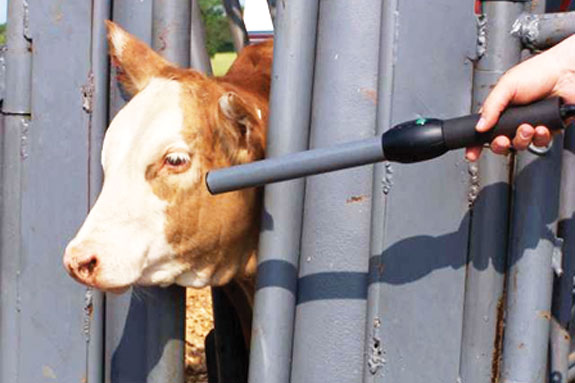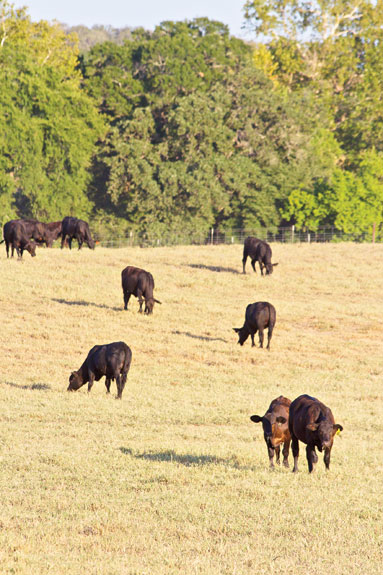Forecasting the future, however, is extremely difficult and almost always inaccurate.
Based on changes in the recent past, however, we can predict new trends.
Rapid changes
Things were quite different during the early 1960s than they are today. For example, the average national cattle pregnancy rate was 72 percent and the average weaning weight was about 425 pounds.
Today, the national weaning weight is 550 pounds or more and pregnancy rates of around 90 percent are more typical.
A typical market steer during the 1960s weighed about 950 pounds and probably had about an inch of back fat.
In the ’60s, slide rules were used to solve problems; calculators or personal computers were almost nonexistent. Expected Progeny Difference (EPD) reports were not available.
In addition, there was no performance testing of cattle and selection was, for the most part, done through visual appraisal and by pedigree. Most cattle were sold at the auction barn.
Large steers weighed about 1,000 pounds and brought 30 to 40 cents per pound. Today, 750-pound yearling steers are being sold for $140 per hundredweight.
In the past, yield Grade 4 cattle were in demand and brought premium prices over cattle with less than half an inch of back fat because fat was desirable.
The feedlot industry as we know it today was just getting started – but the larger feedlots of Kansas and Texas did not exist.
With a place big enough to run 300 head of cattle and a small debt load, a rancher could make a good living, raise a family and be able to keep two sons home to work on the ranch. This is no longer feasible today.
These and other changes in production practices have resulted in tremendous changes for the ranching industry, and cattle production has greatly increased over what was achieved in the 1960s.
The rate of change that has been observed will continue both in society and in the ranching industry.
There will be constant innovations and changes and ranchers will have to identify those innovations that should be embraced and those that should not.
Four steps to making decisions
How does a manager determine which innovations to implement? Primarily, it is very important to know as much as possible about the industry in order to be aware of the innovations that are available.
People in this industry have access to a wide array of scientific articles, magazines, textbooks and symposia about ranching.
It is a mistake to believe that one has enough knowledge, mainly because things are changing so rapidly in this industry. Knowledge is power.
Toward that goal, I recommend a four-step decision-making process for selecting innovations.
1. Scientific soundness
First, determine whether the innovation is scientifically sound. For example, in the early 1960s, “mineral buffets” were an exciting new trend.
These mineral feeders were composed of a number of brightly colored sections that each contained a different mineral, such as cobalt, selenium, etc.
The claim was that cows would take only the minerals they needed, which would hypothetically save money.
The scientific soundness of this program, however, was poor because cows do not balance their mineral intake, but select for palatability. The best decision was, and is, to simply provide a balanced mineral supplement to cattle at all times.
2. Financial viability
Will the use of this innovation make money? Many scientifically sound innovations will not meet this requirement.
An example of a scientifically sound innovation that is not financially viable is the feeding of chelated minerals.
Chelated minerals are those that are bound to an organic substance and are more readily absorbed in the gut than most inorganic minerals.
However, the price of chelated minerals exceeds that of inorganic minerals to the point that performance seldom justifies the added expense.
3. Is it workable?
It may be scientifically sound and financially viable but, given the limitations of some ranching operations, will the operator be able to implement the plan with the given labor and resources?
Artificial insemination (AI) is an excellent example. This innovation is scientifically sound and is also financially beneficial to an operation that wants to use superior bull semen instead of purchasing and maintaining bulls.
On some ranches, however, access to cattle because of brush or other limitations is not feasible for AI on a large scale.
4. Does it fit into the system?
The final step is to determine whether the innovation fits into the system being used. For example, some ranches may consider wildlife as important as livestock.
Some grasses might provide excellent forage for livestock but they might not be beneficial to wildlife.
The yields and production of Tifton 88 bermudagrass in South Texas are very high and results in excellent body condition of cattle during the summer months.
However, wildlife use this grass very little. Furthermore, frosted bermudagrass is poor winter feed, and cattle cannot be grazed in these pastures during winter months.
Ultimately, bermuda is a great grass if the effects on cattle during the summer months are considered, but it does not fit into the cattle/wildlife system used on all ranches.
Examples of the decision process
This four-step decision process is illustrated in the following four innovations often considered on large ranches: One in the biotechnology area, two in electronics and one in grazing systems.
Embryo transplant
During the mid-1970s to late 1970s, this was a popular research trend. The scientific soundness of this technology was two-sided.
In some cases, ET is feasible and financially viable. For example, Henry and Mark Gardiner have probably the best black Angus cattle in the nation, which were developed using truly superior sires and ET.
In that scenario, this technology makes sense. Ultimately, however, to simply apply technology because it is a trend without fully considering the scientific veracity and value of the technology is something to be avoided.

Electronic ID
One of the electronic technologies evaluated here is the use of radio frequency identification (EID), which is a popular trend.
Google lists over 3 million hits on radio frequency ID and beef cattle. Many of the larger ranches in the U.S. have been approached by companies trying to attract investors in this area of technology.
It is possible that animal ID may be important in the future and has some merits regarding soundness, but some programs have seen high failure rates (10 percent) of tags in the field.
In addition, a study that compared tracking rates between EID and DNA into packing plants resulted in an EID accuracy of only 92 percent, mainly because of tracking problems once the head was separated from the carcass.
GIS technology
Today GIS is one of the key tools used in rangeland management on King Ranch. It has proven to be scientifically sound and is a diverse tool which can be integrated with the use of geographic positioning systems (GPS) and computer mapping systems.
This tool has proven to be indispensable on many ranches for various purposes, particularly with designing and sculpting brush management mosaics.
This technology is used to precisely guide heavy machinery operators in brush that can be over 10 feet tall.
Wildlife biologists and range ecologists also use GPS instrumentation and GIS mapping during aerial surveys. The resulting accuracy effectively reduces costs for brush control by approximately 15 percent.
In addition, accurate maps with layers of information have been developed for ranches, allowing for the calculation of pasture sizes and vegetation composition.
They have also been able to accumulate databases on fences, roads, brush treatment and grazing, including repair dates, rotation schedules and more.
This will allow for future reference of brush management, fence records and other pertinent information.

Grazing systems
Grazing systems have also been evaluated using the four-step decision process.
The Savory Grazing system has contributed significantly to range management and improvement over the years.
Parts of this system appear to be scientifically sound while others, such as hoof action and doubled stocking rates, have been highly debated by range experts.
In addition, the financial viability of installing hundreds of miles of fence over such a large area was very low.
Workability also proved to be impractical due to the difficulty in frequently gathering cattle in south Texas brush country, and thus did not fit into the system.
The Merrill System, however, did pass the test. Based on research, this system was proven to be scientifically sound for range, wildlife and cattle performance.
It was also financially viable because costs were minimal due to King Ranch’s current fencing system.
During a drought on one south Texas ranch from 1999 to 2001, weaning weights of cattle on the Merrill Grazing Systems were 538 pounds – for cattle outside of the Merrill system, however, weaning weights were only 497 pounds.
The pregnancy rate was 91 percent for the Merrill and 83 percent for the others.
Innovation testing
When implementing new innovations, it is important to test them on a small scale. Large mistakes can be costly but a few small ones may not cause too much damage.
For example, the Merrill System was implemented on only eight pastures over three years on the south Texas ranch referred to above.
Over time, it appeared to be successful and ranch employees also accepted it.
The above examples provide an idea of the thought process involved with making right decisions in a ranching operation.
One should be watchful for new innovations, and be quick to learn more about each one. Our jobs as ranch managers is to see if they will work, contribute to, and can be integrated into a profitable management system. ![]()
PHOTOS
TOP: Calves from embryo transfer can fetch much higher prices but only if the maternal traits prove to be genetically superior. Photo courtesy of Progressive Cattleman staff.
MIDDLE: Larger ranches are commonly using more electronic ID products and software, but the trend is growing nationwide. Photo courtesy of Texas AgriLife.
BOTTOM: To adopt an innovative grazing system you must make sure the science and practical applications meet the expectations for your ranch. Photo courtesy of Progressive Cattleman staff.

Paul Genho
President
Farmland Reserve, Inc.
Paul Genho was the general manager of the King Ranch from 1998 to 2004, and was a catalyst in development of the King Ranch Institute for Ranch Management at Texas A&M University – Kingsville.






